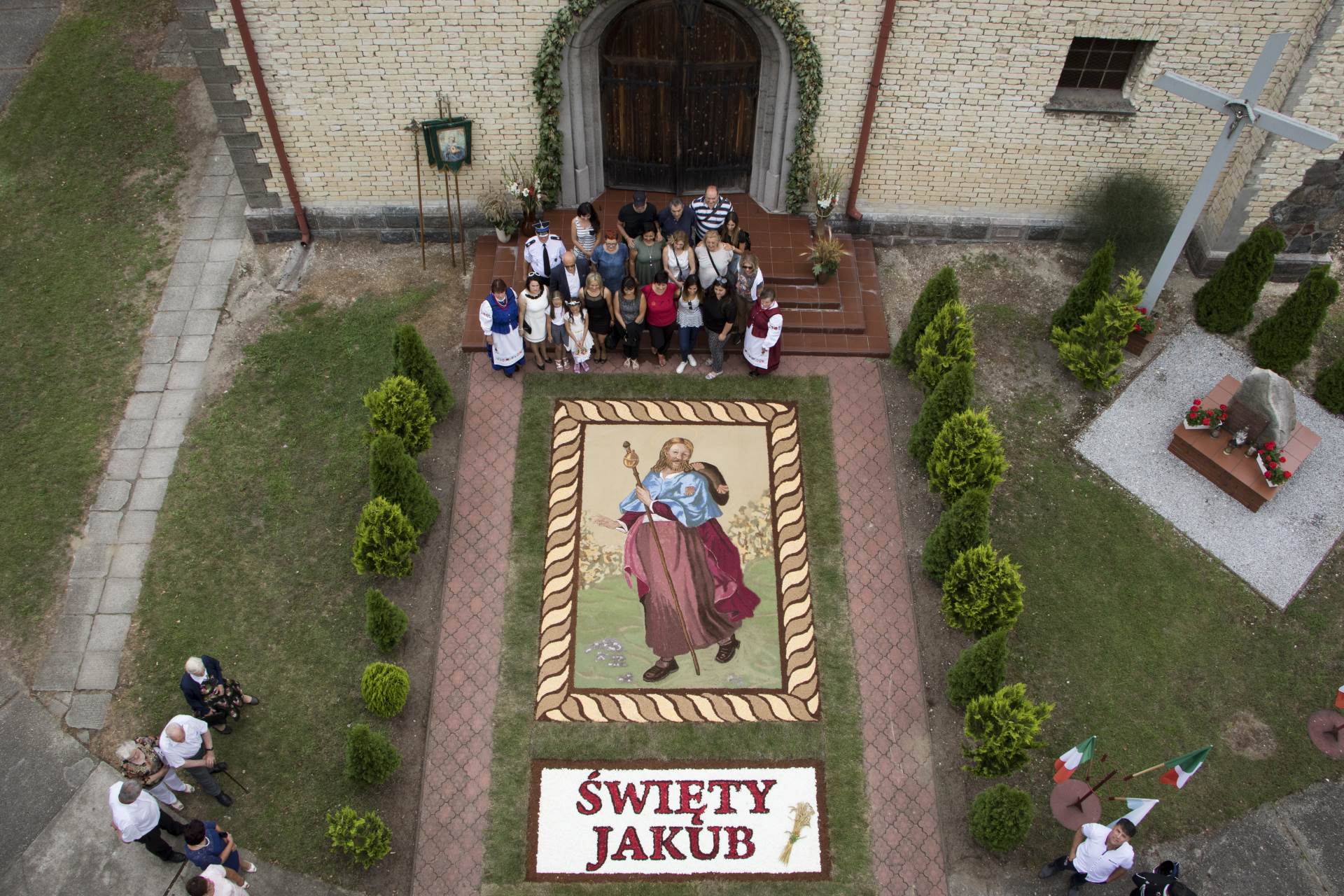For over 200 years the inhabitants of Spycimierz, a little village in the municipality of Uniejów (central Poland), create colourful flower carpets with a length of almost 1 km along the Corpus Christi procession route. Come to Spycimierz to experience this special feast. The tradition is included in the UNESCO world list.
Vibrant flowers from the immediate area
Just a few days before the holiday, a real action takes place in the village – the inhabitants first collect flowers from nearby fields and home gardens, then sort, prepare and store in a cool place until Corpus Christi. On the holiday itself, entire families start arranging previously thought-out designs. They draw them first with chalk on the cobblestones – by hand or according to templates, then lay out the contours of the black soil wet with water. At the end they put colourful flowers on it. The effect is always impressive! Both children, teenagers and adults participate in the preparation and implementation of floral arrangements.
Intricate designs
Initially, only yellow sand and tree branches were used for decoration. Flowers as a decorative element were introduced in the 1920s. Among the motifs arranged on floral rugs, symbols and religious paintings, rosettes and other floral compositions dominate. Artistic material – in addition to colorful flowers – are leaves, branches of shrubs, ears of cereals and tree bark.
Gates
Gates are a unique element of the Spycimier ceremony. At present, two are erected: one above the procession passage, the other at the entrance to the church square. These are solid constructions 6 meters high and 4 meters wide, which must be prepared much earlier. The frame of the gates is encased in branches of coniferous trees, in which colorful flowers are woven into.
From the upper beam, on which the cross and the religious image are fixed, garlands hang from the delicate parts of spruce branches intertwined with flowers. Preparation of gates requires both technical and artistic skills. The number of gates has varied – from 5-6 to even 8 gates. Flower gates as a symbol of the passage complement the symbolism of flower rugs.
Solemn procession
The Feast of Corpus Christi (Body of Christ) is a Catholic liturgical solemnity celebrating annually 60 days after Easter. It emphasizes belief in the body and blood of Jesus Christ as well as institution of the Eucharist. Besides the Holy Mass and processions, in several places of the world the unique tradition of composing floral carpets developed.
In Poland, the feast of Corpus Christi has been celebrated since the beginning of the 14th century. At the end of the century, the feast was already celebrated in all Polish dioceses. In Poland corpus Christi is celebrated in a very special way. Processions have taken place in every parish since the 15th century to the present day. Usually, the procession sets off from the church, and then moves to four altars arranged in a distance from the temple. The Gospel is read at each of them.
In Spycimierz, the procession crowns the hard work of parishioners. Many of them belong to the parish, local brass band and volunteer fire brigade. At 17.00 a solemn mass begins in the parish church of the Exaltation of the Holy Cross, in the center of the village, followed by a procession with the Blessed Sacrament to four altars built on the route. The charm of the procession attracts more and more people every year. It is documented by tourists and pilgrims, journalists, photographers, as well as by television. The parishioners are proud of their tradition. They don’t care about the effort of preparing the ceremony. This is their way of confessing their faith in God and giving Him due worship.
Read more about flower carpets and Spycimierz.
Tradition handed down from generation to generation
The Spycimierz tradition lives on and is passed on from generation to generation. The parishioners and the Uniejów Commune also care for its safeguarding through participation in projects co-financed by the Ministry of Culture and National Heritage and numerous investments, including the construction of the Spycimierz Corpus Christi Centre.
The crowning achievement of these efforts is the entry on the UNESCO Representative List of the Intangible Cultural Heritage of Humanity. This took place on 16 December 2021 during the session of the UNESCO Intergovernmental Committee for the Safeguarding of the Intangible Cultural Heritage in Paris. It is the third tradition from Poland to be included on the world list. Read more about UNESCO and the world list.
Earlier, in 2018, the Minister of Culture and National Heritage inscribed the Spycimiera tradition on the National List of Intangible Cultural Heritage.
Italian flower pictures
Above all the cooperation with Uniejów’s Italian association “Infioritalia” brought a beautiful tradition to Uniejów. Yearly during Corpus Christi guests from different Italian cities lay beautiful pictures with colourful flowers. You can admire these art works in the parish churches in Spycimierz, Wilamów and Wielenin as well as on squares and streets in the city of Uniejów.
See artists from Uniejów’s Italian twin town Alatri at work on their wonderful art pieces (2016):








